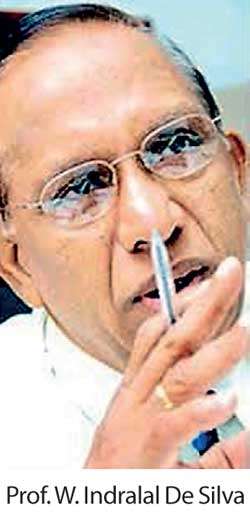Reply To:
Name - Reply Comment
 By Nishel Fernando
By Nishel Fernando
Sri Lanka is set to face higher demand for housing, health, food, education, employment, energy, water, transportation and infrastructure amid unexpected growth in population driven by a significant upturn in recent fertility rates and anticipated inward migration.
Participating in the Annual Sessions of the Sri Lanka Economic Association last week, leading demographist and University of Colombo Emeritus Professor of Demography, Prof. W. Indralal De Silva said Sri Lanka’s population is projected to increase to 25 million by 2042 and will reach 26 million by 2060s mainly due to a significant upturn in fertility rates.
“Along with the fertility increase, child population will increase from 5.1 million in 2012 to 5.3 million by 2017, and for the subsequent 10 to 20 years it would remain fairly static,” he said.
He pointed out that the increase in younger population would generate pressure on the government and the labour force as overall dependency will increase significantly.
According to De Silva, labour migration has also significantly declined in recent years and it is expected to further decline, creating more demand for housing, health, food, water etc.
“Few years back, annual departures were over 300,000 from the country, but it has now declined to 220,000-240,000. The number will further decline significantly in coming years.”
In addition, he remarked that inward migration would significantly increase as mega development projects such as Colombo Port City (CPC) are taking off.
He claimed that CPC alone is projected to bring over 100,000 migrant workers into the country, where the majority are expected reside within CPC and Colombo municipality area.
“It’s extremely difficult to find out what the real activities are going to be and also how much residential facilities will be required. Some of the Chinese workers will also be coming with their families,” he said.
He further estimates that nearly 40,000 migrant workers are already in the country, both legally and illegally, and are employed in various sectors from construction to agriculture.
Elaborating on the implications from a significant growth in population, De Silva said, “A significant growth in the population in Sri Lanka would create serious implication of economic and social at serious levels in coming decades.
“All these issues are expected to impact implicitly and explicitly on the socio-economic progress of the nation. Along with the rapid aging process, the unexpected fertility upturn would generate more pressure on the working population and the State.”
De Silva emphasised that the congested towns as well as air and water pollution have become increasingly frequent in the country, in addition to environmental degradation.
He suggested that Sri Lanka should be looking into policies such as increasing the retirement age in order to reduce the burden on the labour force and government, as the population of over 60 is projected to reach 23.8 percent of the overall population by 2032 from current 15 percent despite the increase in the young population, which has nevertheless eased off rapid ageing.
“The retirement age of the ageing needs to be increased, because a female even after 60 years of age, can live another 22 years on average while a male above 60 years can live another 17 years. Therefore, the retirement age needs to be increased in coming years,” he stressed.
Although the demographic dividend or demographic bonus where the working-age population is larger than the non-working-age share of the population will be available for few more years due to the unexpected upturn in fertility rates, he pointed out that successive governments which ruled the country have failed to capitalise on it.
Sri Lanka’s working-age population exceeded the non-working-age share of the population in 1991. According to De Silva’s projection, the demographic dividend would be available until 2034 in standard definition (15-64 years) while in terms of alternative definition (15-59 years) would be available until this year.
However, he stressed that Sri Lanka in fact missed the bus as the best part of the labour dividend has already disappeared.
Explaining the possible reasons behind the unexpected upturn in fertility rates, he said that a considerable share of the population in post-war Sri Lanka has become really concerned about their share in the population, which has pushed fertility rates.
Moreover, other factors such as the decrease of age of marriage and increase of remarriage rate, withdrawal of abortion service and weakening of contraceptive delivery services, stagnation of female labour force participation, increase of employment rate, treatment for sub fertility and impact of Tsunami and other factors led females to have more children.
De Silva pointed out that the median age of marriage has fallen to the lowest since 1970 for both males and females to 27.2 and 23.4 respectively, while contraceptive use among married women has fallen to 64.6 percent in 2016 from the peak of 70.2 percent in 2006-2007 period.
He averred that political stability, savings and investment, knowledge economy and the government’s commitment to reduce corruption are crucial to achieve an economic take-off from the demographic dividend, as seen in countries such as India, China and South Korea.